Презентация an-introduction-to-medical-parasitology-12893


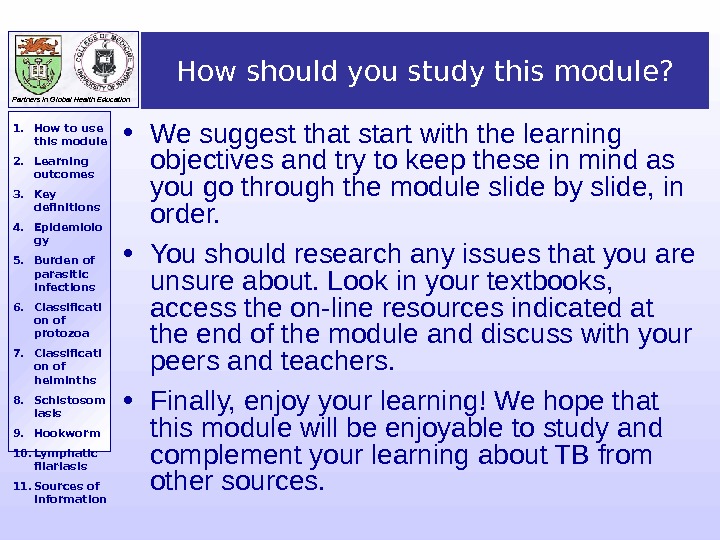
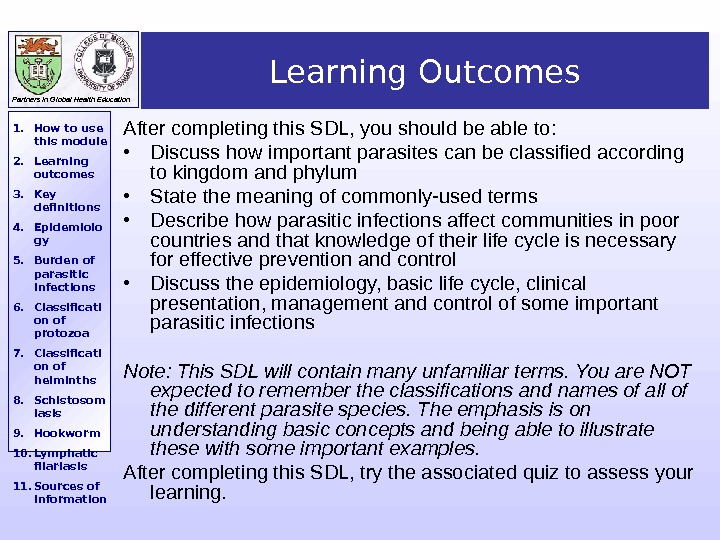
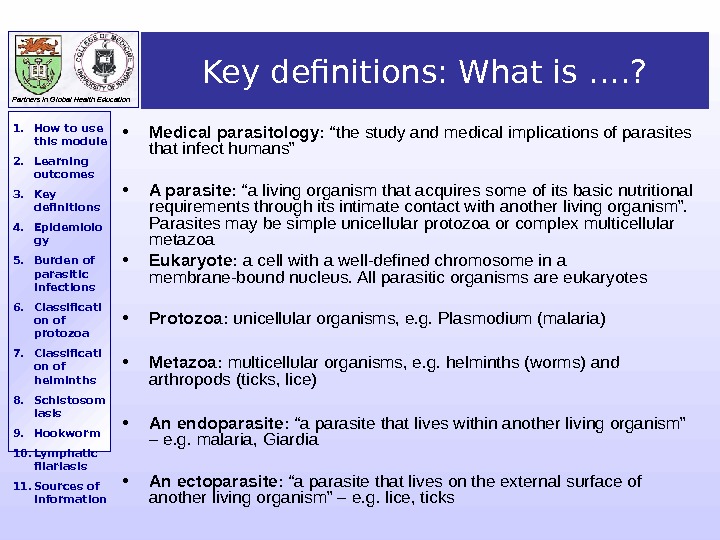
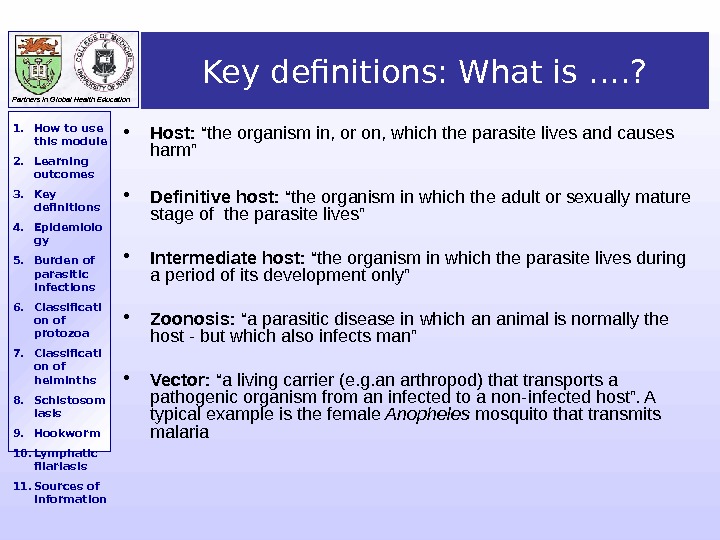
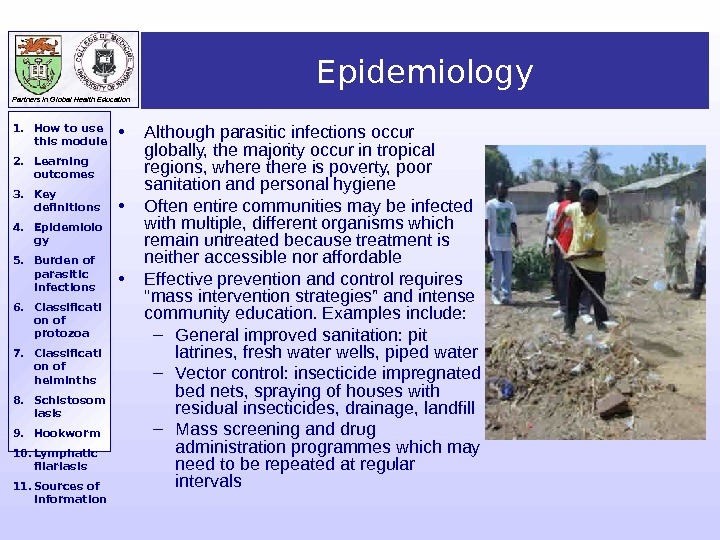
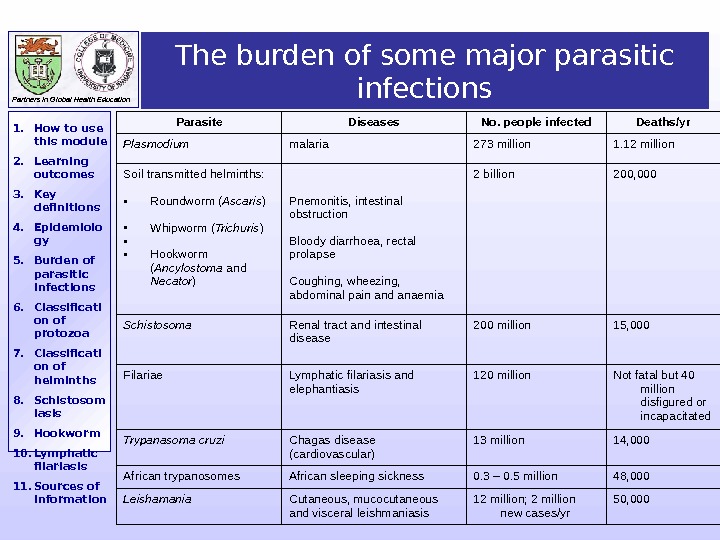
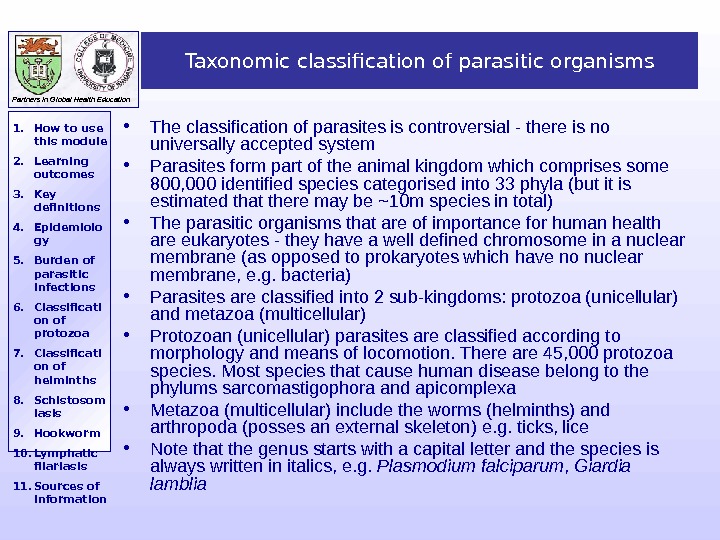
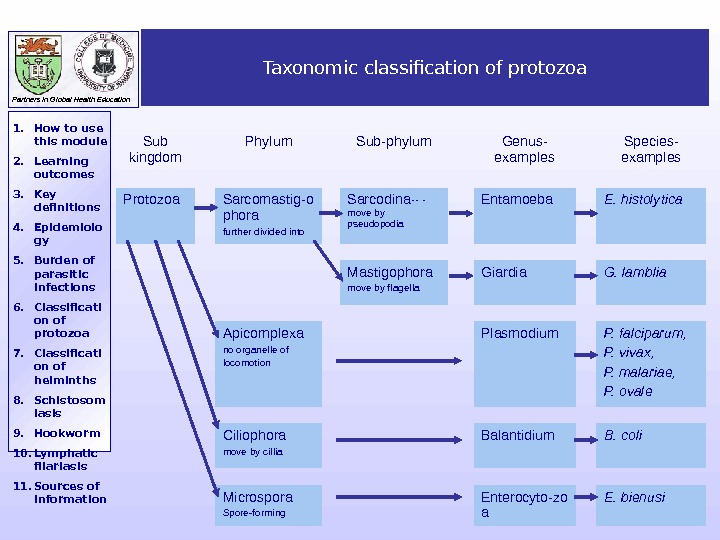

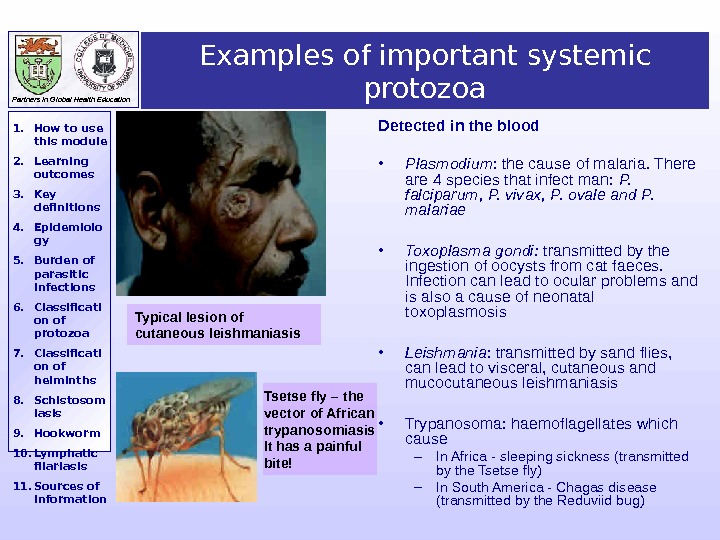
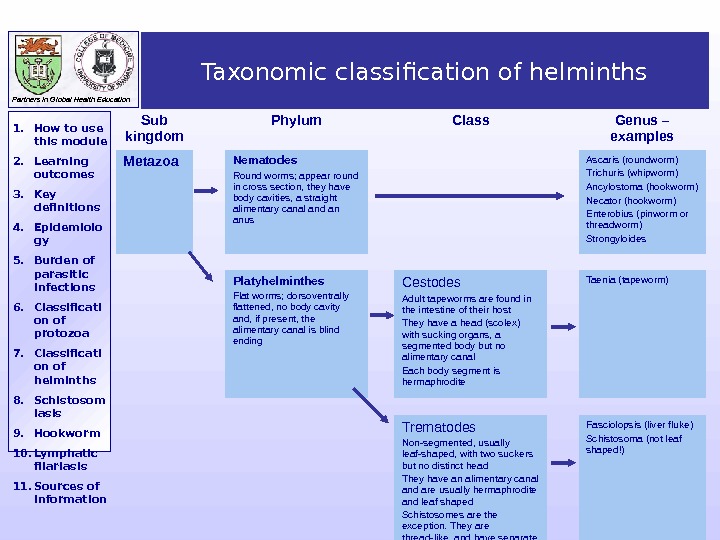
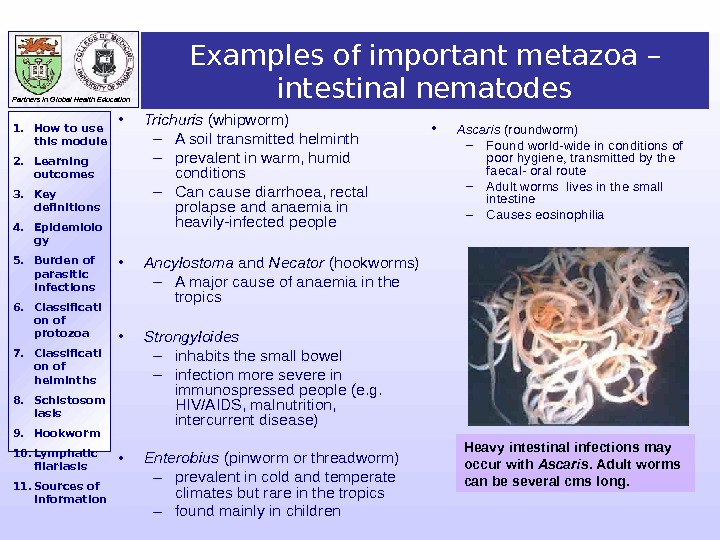
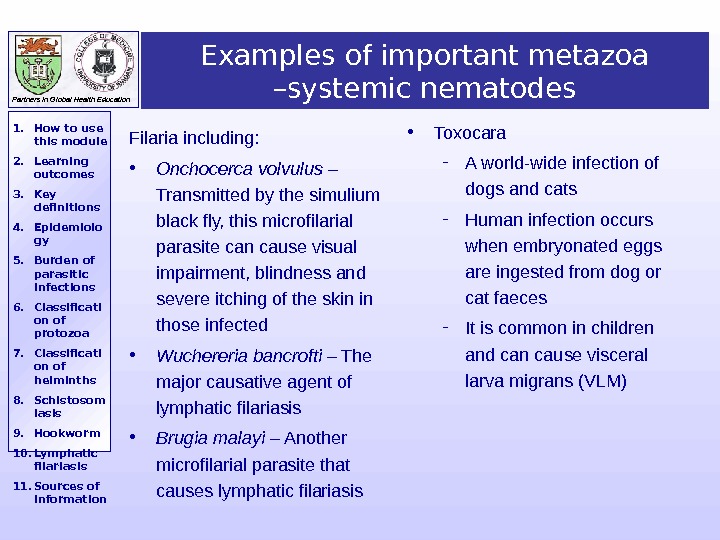

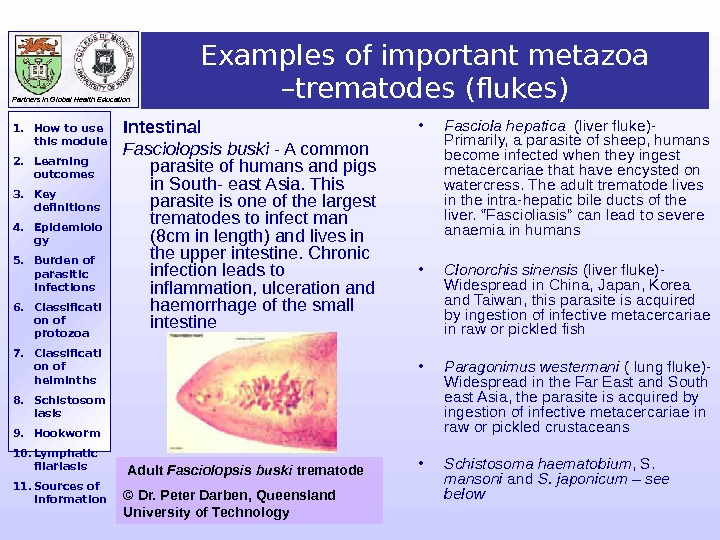
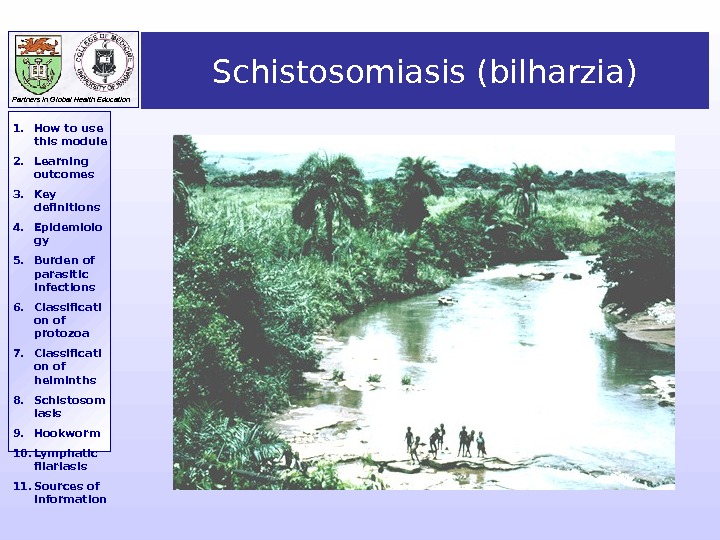

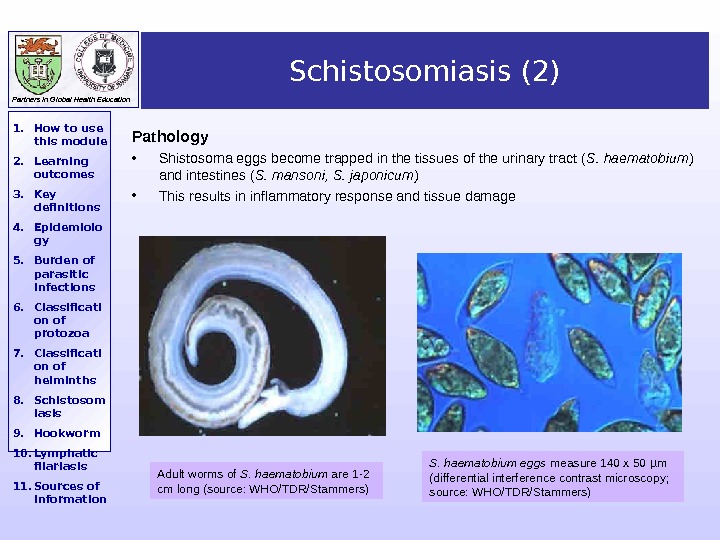
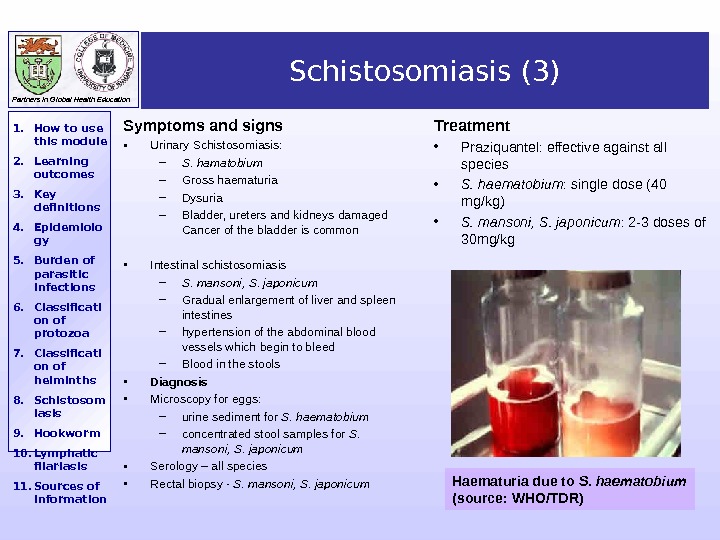
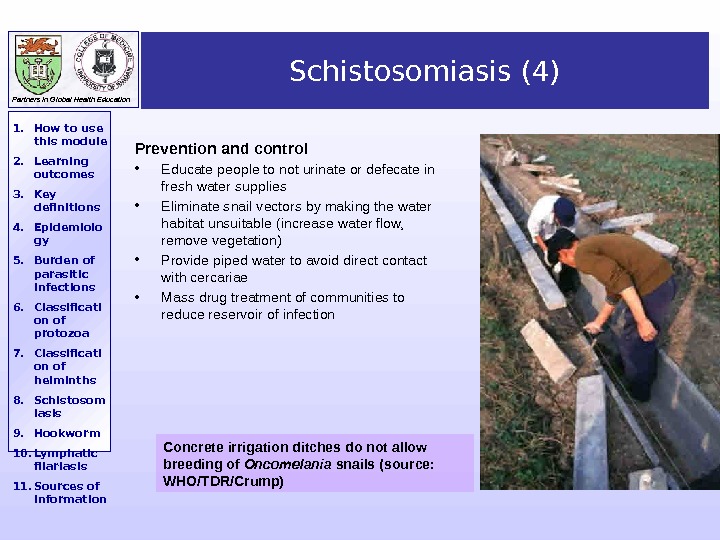
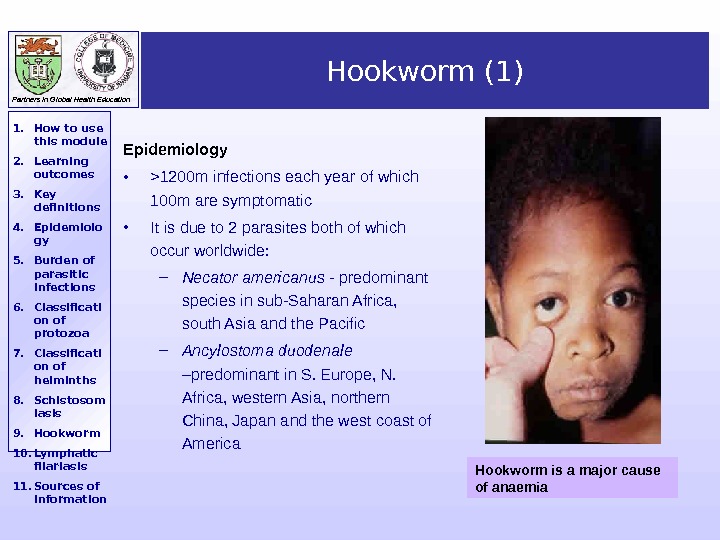
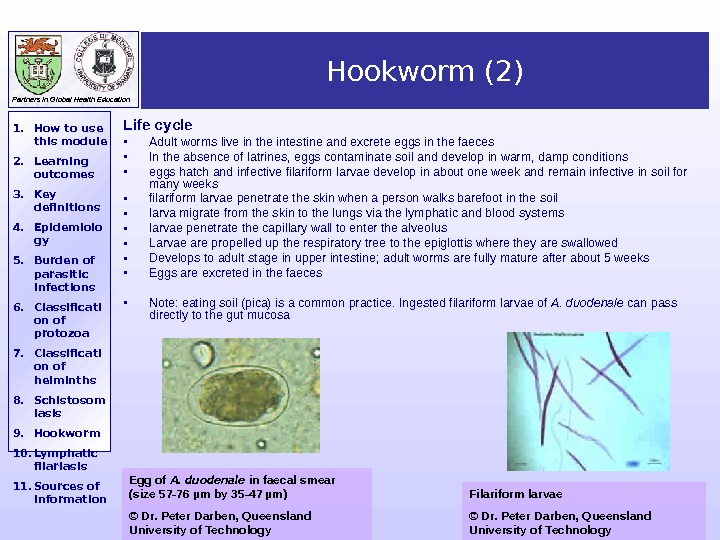
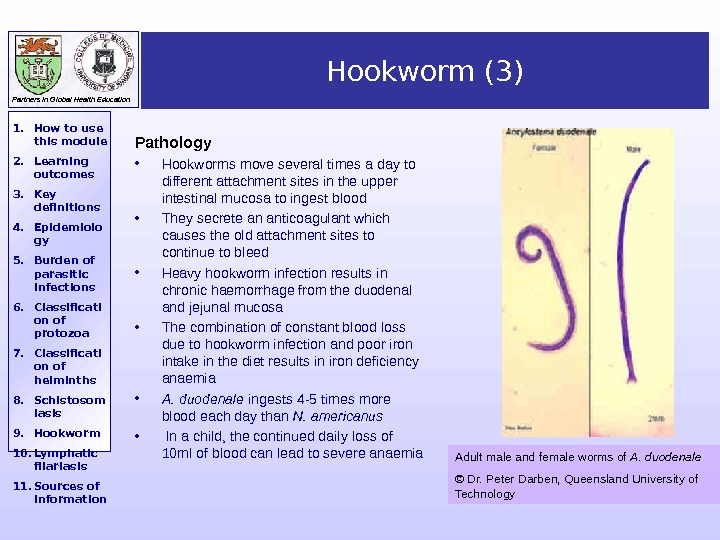
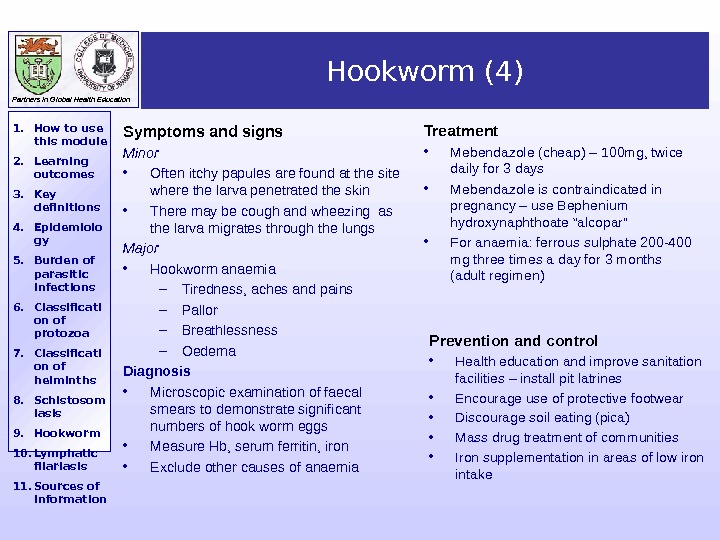
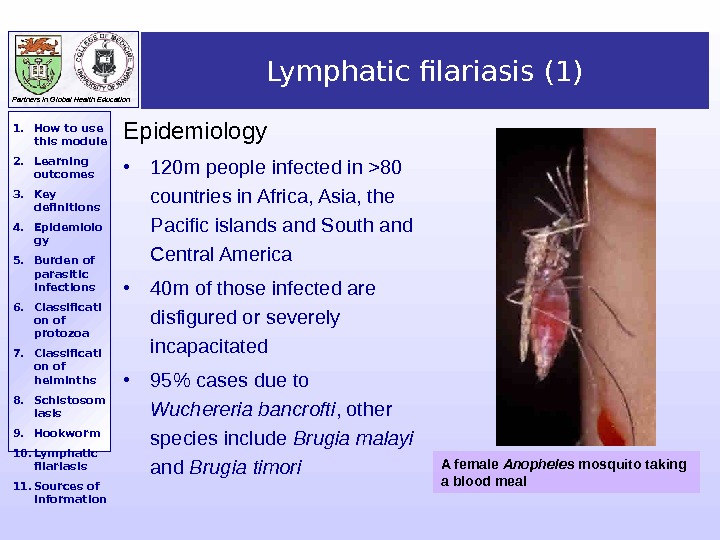
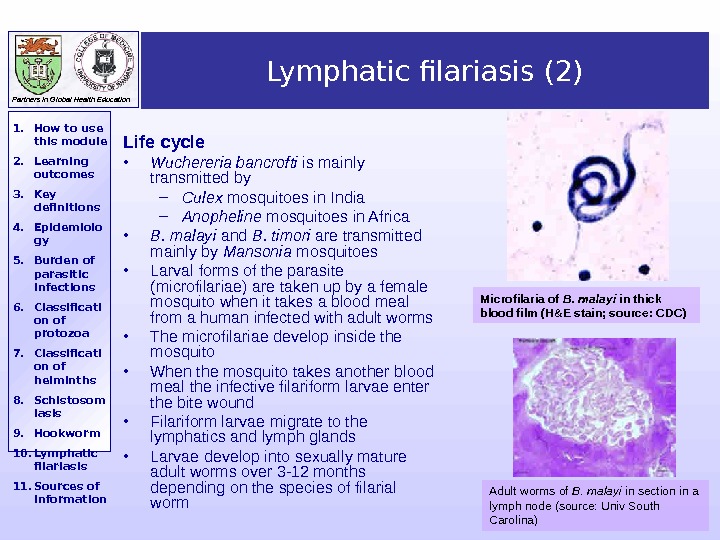
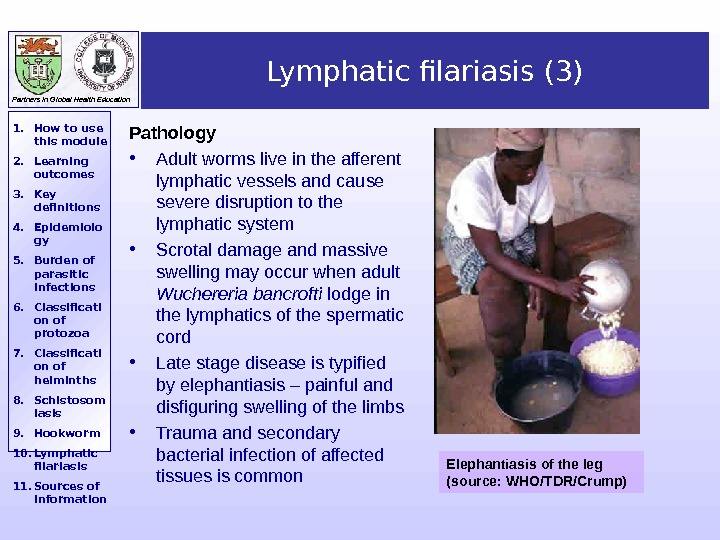
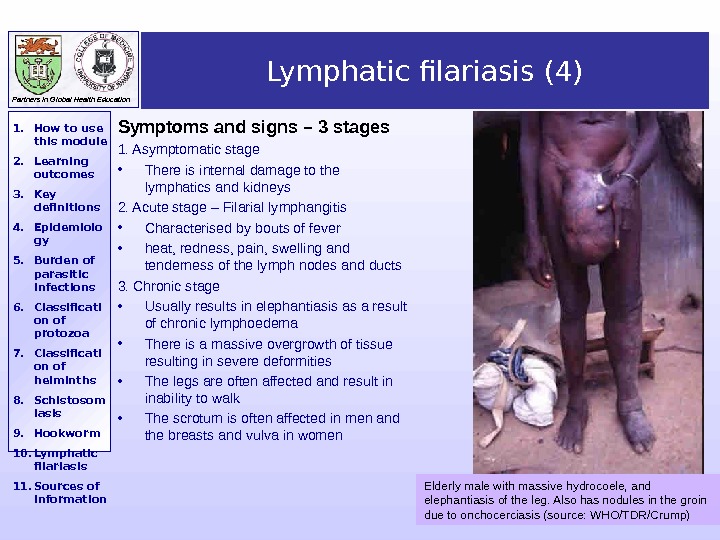
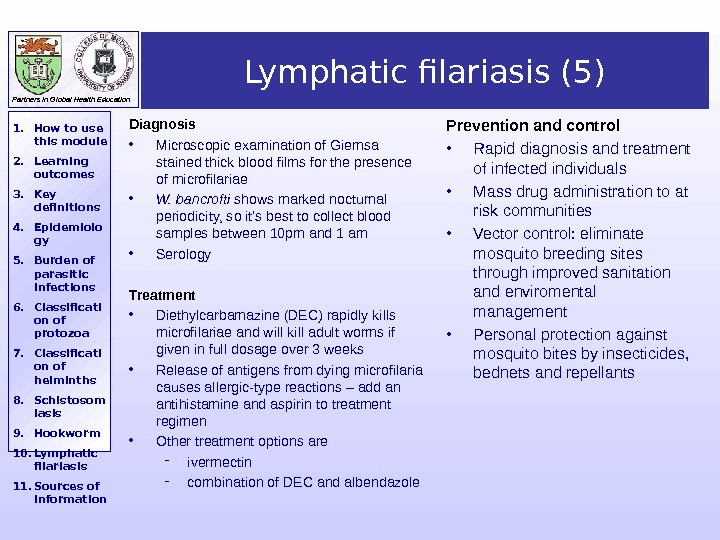
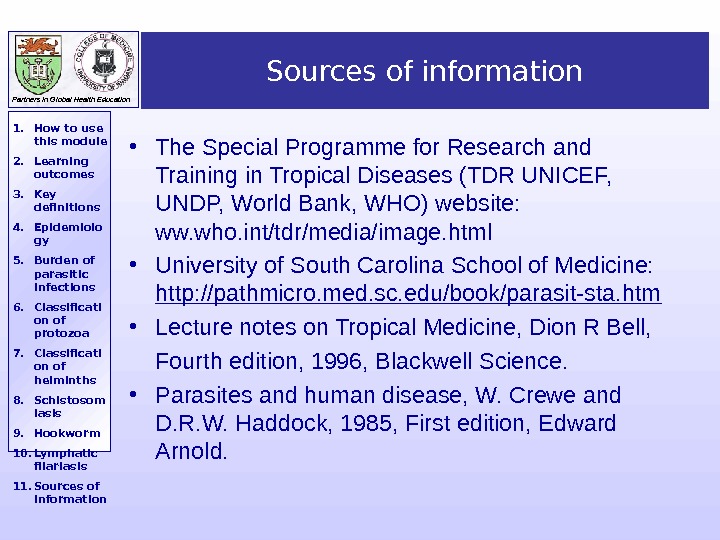
an-introduction-to-medical-parasitology-12893.ppt
- Размер: 1.2 Mегабайта
- Количество слайдов: 31
Описание презентации Презентация an-introduction-to-medical-parasitology-12893 по слайдам
 Partners in Global Health Education 1. How to use this module 2. Learning outcomes 3. Key definitions 4. Epidemiolo gy 5. Burden of parasitic infections 6. Classificati on of protozoa 7. Classificati on of helminths 8. Schistosom iasis 9. Hookworm 10. Lymphatic filariasis 11. Sources of information An introduction to Medical Parasitology For more information about the authors and reviewers of this module, click here
Partners in Global Health Education 1. How to use this module 2. Learning outcomes 3. Key definitions 4. Epidemiolo gy 5. Burden of parasitic infections 6. Classificati on of protozoa 7. Classificati on of helminths 8. Schistosom iasis 9. Hookworm 10. Lymphatic filariasis 11. Sources of information An introduction to Medical Parasitology For more information about the authors and reviewers of this module, click here
 Partners in Global Health Education 1. How to use this module 2. Learning outcomes 3. Key definitions 4. Epidemiolo gy 5. Burden of parasitic infections 6. Classificati on of protozoa 7. Classificati on of helminths 8. Schistosom iasis 9. Hookworm 10. Lymphatic filariasis 11. Sources of information How should you study this module? • We suggest that start with the learning objectives and try to keep these in mind as you go through the module slide by slide, in order. • You should research any issues that you are unsure about. Look in your textbooks, access the on-line resources indicated at the end of the module and discuss with your peers and teachers. • Finally, enjoy your learning! We hope that this module will be enjoyable to study and complement your learning about TB from other sources.
Partners in Global Health Education 1. How to use this module 2. Learning outcomes 3. Key definitions 4. Epidemiolo gy 5. Burden of parasitic infections 6. Classificati on of protozoa 7. Classificati on of helminths 8. Schistosom iasis 9. Hookworm 10. Lymphatic filariasis 11. Sources of information How should you study this module? • We suggest that start with the learning objectives and try to keep these in mind as you go through the module slide by slide, in order. • You should research any issues that you are unsure about. Look in your textbooks, access the on-line resources indicated at the end of the module and discuss with your peers and teachers. • Finally, enjoy your learning! We hope that this module will be enjoyable to study and complement your learning about TB from other sources.
 Partners in Global Health Education 1. How to use this module 2. Learning outcomes 3. Key definitions 4. Epidemiolo gy 5. Burden of parasitic infections 6. Classificati on of protozoa 7. Classificati on of helminths 8. Schistosom iasis 9. Hookworm 10. Lymphatic filariasis 11. Sources of information Learning Outcomes After completing this SDL, you should be able to: • Discuss how important parasites can be classified according to kingdom and phylum • State the meaning of commonly-used terms • Describe how parasitic infections affect communities in poor countries and that knowledge of their life cycle is necessary for effective prevention and control • Discuss the epidemiology, basic life cycle, clinical presentation, management and control of some important parasitic infections Note: This SDL will contain many unfamiliar terms. You are NOT expected to remember the classifications and names of all of the different parasite species. The emphasis is on understanding basic concepts and being able to illustrate these with some important examples. After completing this SDL, try the associated quiz to assess your learning.
Partners in Global Health Education 1. How to use this module 2. Learning outcomes 3. Key definitions 4. Epidemiolo gy 5. Burden of parasitic infections 6. Classificati on of protozoa 7. Classificati on of helminths 8. Schistosom iasis 9. Hookworm 10. Lymphatic filariasis 11. Sources of information Learning Outcomes After completing this SDL, you should be able to: • Discuss how important parasites can be classified according to kingdom and phylum • State the meaning of commonly-used terms • Describe how parasitic infections affect communities in poor countries and that knowledge of their life cycle is necessary for effective prevention and control • Discuss the epidemiology, basic life cycle, clinical presentation, management and control of some important parasitic infections Note: This SDL will contain many unfamiliar terms. You are NOT expected to remember the classifications and names of all of the different parasite species. The emphasis is on understanding basic concepts and being able to illustrate these with some important examples. After completing this SDL, try the associated quiz to assess your learning.
 Partners in Global Health Education 1. How to use this module 2. Learning outcomes 3. Key definitions 4. Epidemiolo gy 5. Burden of parasitic infections 6. Classificati on of protozoa 7. Classificati on of helminths 8. Schistosom iasis 9. Hookworm 10. Lymphatic filariasis 11. Sources of information Key definitions: What is …. ? • Medical parasitology: “the study and medical implications of parasites that infect humans” • A parasite: “a living organism that acquires some of its basic nutritional requirements through its intimate contact with another living organism”. Parasites may be simple unicellular protozoa or complex multicellular metazoa • Eukaryote: a cell with a well-defined chromosome in a membrane-bound nucleus. All parasitic organisms are eukaryotes • Protozoa: unicellular organisms, e. g. Plasmodium (malaria) • Metazoa: multicellular organisms, e. g. helminths (worms) and arthropods (ticks, lice) • An endoparasite: “a parasite that lives within another living organism” – e. g. malaria, Giardia • An ectoparasite: “a parasite that lives on the external surface of another living organism” – e. g. lice, ticks
Partners in Global Health Education 1. How to use this module 2. Learning outcomes 3. Key definitions 4. Epidemiolo gy 5. Burden of parasitic infections 6. Classificati on of protozoa 7. Classificati on of helminths 8. Schistosom iasis 9. Hookworm 10. Lymphatic filariasis 11. Sources of information Key definitions: What is …. ? • Medical parasitology: “the study and medical implications of parasites that infect humans” • A parasite: “a living organism that acquires some of its basic nutritional requirements through its intimate contact with another living organism”. Parasites may be simple unicellular protozoa or complex multicellular metazoa • Eukaryote: a cell with a well-defined chromosome in a membrane-bound nucleus. All parasitic organisms are eukaryotes • Protozoa: unicellular organisms, e. g. Plasmodium (malaria) • Metazoa: multicellular organisms, e. g. helminths (worms) and arthropods (ticks, lice) • An endoparasite: “a parasite that lives within another living organism” – e. g. malaria, Giardia • An ectoparasite: “a parasite that lives on the external surface of another living organism” – e. g. lice, ticks
 Partners in Global Health Education 1. How to use this module 2. Learning outcomes 3. Key definitions 4. Epidemiolo gy 5. Burden of parasitic infections 6. Classificati on of protozoa 7. Classificati on of helminths 8. Schistosom iasis 9. Hookworm 10. Lymphatic filariasis 11. Sources of information Key definitions: What is …. ? • Host: “the organism in, or on, which the parasite lives and causes harm” • Definitive host: “the organism in which the adult or sexually mature stage of the parasite lives” • Intermediate host: “the organism in which the parasite lives during a period of its development only” • Zoonosis: “a parasitic disease in which an animal is normally the host — but which also infects man” • Vector: “a living carrier (e. g. an arthropod) that transports a pathogenic organism from an infected to a non-infected host”. A typical example is the female Anopheles mosquito that transmits malaria
Partners in Global Health Education 1. How to use this module 2. Learning outcomes 3. Key definitions 4. Epidemiolo gy 5. Burden of parasitic infections 6. Classificati on of protozoa 7. Classificati on of helminths 8. Schistosom iasis 9. Hookworm 10. Lymphatic filariasis 11. Sources of information Key definitions: What is …. ? • Host: “the organism in, or on, which the parasite lives and causes harm” • Definitive host: “the organism in which the adult or sexually mature stage of the parasite lives” • Intermediate host: “the organism in which the parasite lives during a period of its development only” • Zoonosis: “a parasitic disease in which an animal is normally the host — but which also infects man” • Vector: “a living carrier (e. g. an arthropod) that transports a pathogenic organism from an infected to a non-infected host”. A typical example is the female Anopheles mosquito that transmits malaria
 Partners in Global Health Education 1. How to use this module 2. Learning outcomes 3. Key definitions 4. Epidemiolo gy 5. Burden of parasitic infections 6. Classificati on of protozoa 7. Classificati on of helminths 8. Schistosom iasis 9. Hookworm 10. Lymphatic filariasis 11. Sources of information Epidemiology • Although parasitic infections occur globally, the majority occur in tropical regions, where there is poverty, poor sanitation and personal hygiene • Often entire communities may be infected with multiple, different organisms which remain untreated because treatment is neither accessible nor affordable • Effective prevention and control requires «mass intervention strategies” and intense community education. Examples include: – General improved sanitation: pit latrines, fresh water wells, piped water – Vector control: insecticide impregnated bed nets, spraying of houses with residual insecticides, drainage, landfill – Mass screening and drug administration programmes which may need to be repeated at regular intervals
Partners in Global Health Education 1. How to use this module 2. Learning outcomes 3. Key definitions 4. Epidemiolo gy 5. Burden of parasitic infections 6. Classificati on of protozoa 7. Classificati on of helminths 8. Schistosom iasis 9. Hookworm 10. Lymphatic filariasis 11. Sources of information Epidemiology • Although parasitic infections occur globally, the majority occur in tropical regions, where there is poverty, poor sanitation and personal hygiene • Often entire communities may be infected with multiple, different organisms which remain untreated because treatment is neither accessible nor affordable • Effective prevention and control requires «mass intervention strategies” and intense community education. Examples include: – General improved sanitation: pit latrines, fresh water wells, piped water – Vector control: insecticide impregnated bed nets, spraying of houses with residual insecticides, drainage, landfill – Mass screening and drug administration programmes which may need to be repeated at regular intervals
 Partners in Global Health Education 1. How to use this module 2. Learning outcomes 3. Key definitions 4. Epidemiolo gy 5. Burden of parasitic infections 6. Classificati on of protozoa 7. Classificati on of helminths 8. Schistosom iasis 9. Hookworm 10. Lymphatic filariasis 11. Sources of information The burden of some major parasitic infections Parasite Diseases No. people infected Deaths/yr Plasmodium malaria 273 million 1. 12 million Soil transmitted helminths: • Roundworm ( Ascaris ) • Whipworm ( Trichuris ) • • Hookworm ( Ancylostoma and Necator ) Pnemonitis, intestinal obstruction Bloody diarrhoea, rectal prolapse Coughing, wheezing, abdominal pain and anaemia 2 billion 200, 000 Schistosoma Renal tract and intestinal disease 200 million 15, 000 Filariae Lymphatic filariasis and elephantiasis 120 million Not fatal but 40 million disfigured or incapacitated Trypanasoma cruzi Chagas disease (cardiovascular) 13 million 14, 000 African trypanosomes African sleeping sickness 0. 3 – 0. 5 million 48, 000 Leishamania Cutaneous, mucocutaneous and visceral leishmaniasis 12 million; 2 million new cases/yr 50,
Partners in Global Health Education 1. How to use this module 2. Learning outcomes 3. Key definitions 4. Epidemiolo gy 5. Burden of parasitic infections 6. Classificati on of protozoa 7. Classificati on of helminths 8. Schistosom iasis 9. Hookworm 10. Lymphatic filariasis 11. Sources of information The burden of some major parasitic infections Parasite Diseases No. people infected Deaths/yr Plasmodium malaria 273 million 1. 12 million Soil transmitted helminths: • Roundworm ( Ascaris ) • Whipworm ( Trichuris ) • • Hookworm ( Ancylostoma and Necator ) Pnemonitis, intestinal obstruction Bloody diarrhoea, rectal prolapse Coughing, wheezing, abdominal pain and anaemia 2 billion 200, 000 Schistosoma Renal tract and intestinal disease 200 million 15, 000 Filariae Lymphatic filariasis and elephantiasis 120 million Not fatal but 40 million disfigured or incapacitated Trypanasoma cruzi Chagas disease (cardiovascular) 13 million 14, 000 African trypanosomes African sleeping sickness 0. 3 – 0. 5 million 48, 000 Leishamania Cutaneous, mucocutaneous and visceral leishmaniasis 12 million; 2 million new cases/yr 50,
 Partners in Global Health Education 1. How to use this module 2. Learning outcomes 3. Key definitions 4. Epidemiolo gy 5. Burden of parasitic infections 6. Classificati on of protozoa 7. Classificati on of helminths 8. Schistosom iasis 9. Hookworm 10. Lymphatic filariasis 11. Sources of information Taxonomic classification of parasitic organisms • The classification of parasites is controversial — there is no universally accepted system • Parasites form part of the animal kingdom which comprises some 800, 000 identified species categorised into 33 phyla (but it is estimated that there may be ~10 m species in total) • The parasitic organisms that are of importance for human health are eukaryotes — they have a well defined chromosome in a nuclear membrane (as opposed to prokaryotes which have no nuclear membrane, e. g. bacteria) • Parasites are classified into 2 sub-kingdoms: protozoa (unicellular) and metazoa (multicellular) • Protozoan (unicellular) parasites are classified according to morphology and means of locomotion. There are 45, 000 protozoa species. Most species that cause human disease belong to the phylums sarcomastigophora and apicomplexa • Metazoa (multicellular) include the worms (helminths) and arthropoda (posses an external skeleton) e. g. ticks, lice • Note that the genus starts with a capital letter and the species is always written in italics, e. g. Plasmodium falciparum , Giardia lamblia
Partners in Global Health Education 1. How to use this module 2. Learning outcomes 3. Key definitions 4. Epidemiolo gy 5. Burden of parasitic infections 6. Classificati on of protozoa 7. Classificati on of helminths 8. Schistosom iasis 9. Hookworm 10. Lymphatic filariasis 11. Sources of information Taxonomic classification of parasitic organisms • The classification of parasites is controversial — there is no universally accepted system • Parasites form part of the animal kingdom which comprises some 800, 000 identified species categorised into 33 phyla (but it is estimated that there may be ~10 m species in total) • The parasitic organisms that are of importance for human health are eukaryotes — they have a well defined chromosome in a nuclear membrane (as opposed to prokaryotes which have no nuclear membrane, e. g. bacteria) • Parasites are classified into 2 sub-kingdoms: protozoa (unicellular) and metazoa (multicellular) • Protozoan (unicellular) parasites are classified according to morphology and means of locomotion. There are 45, 000 protozoa species. Most species that cause human disease belong to the phylums sarcomastigophora and apicomplexa • Metazoa (multicellular) include the worms (helminths) and arthropoda (posses an external skeleton) e. g. ticks, lice • Note that the genus starts with a capital letter and the species is always written in italics, e. g. Plasmodium falciparum , Giardia lamblia
 Partners in Global Health Education 1. How to use this module 2. Learning outcomes 3. Key definitions 4. Epidemiolo gy 5. Burden of parasitic infections 6. Classificati on of protozoa 7. Classificati on of helminths 8. Schistosom iasis 9. Hookworm 10. Lymphatic filariasis 11. Sources of information Taxonomic classification of protozoa Sub kingdom Phylum Sub-phylum Genus- examples Species- examples Protozoa Sarcomastig-o phora further divided into Sarcodina — — move by pseudopodia Entamoeba E. histolytica Mastigophora move by flagella Giardia G. lamblia Apicomplexa no organelle of locomotion Plasmodium P. falciparum, P. vivax, P. malariae, P. ovale Ciliophora move by cillia Balantidium B. coli Microspora Spore-forming Enterocyto-zo a E. bienusi
Partners in Global Health Education 1. How to use this module 2. Learning outcomes 3. Key definitions 4. Epidemiolo gy 5. Burden of parasitic infections 6. Classificati on of protozoa 7. Classificati on of helminths 8. Schistosom iasis 9. Hookworm 10. Lymphatic filariasis 11. Sources of information Taxonomic classification of protozoa Sub kingdom Phylum Sub-phylum Genus- examples Species- examples Protozoa Sarcomastig-o phora further divided into Sarcodina — — move by pseudopodia Entamoeba E. histolytica Mastigophora move by flagella Giardia G. lamblia Apicomplexa no organelle of locomotion Plasmodium P. falciparum, P. vivax, P. malariae, P. ovale Ciliophora move by cillia Balantidium B. coli Microspora Spore-forming Enterocyto-zo a E. bienusi
 Partners in Global Health Education 1. How to use this module 2. Learning outcomes 3. Key definitions 4. Epidemiolo gy 5. Burden of parasitic infections 6. Classificati on of protozoa 7. Classificati on of helminths 8. Schistosom iasis 9. Hookworm 10. Lymphatic filariasis 11. Sources of information Examples of important intestinal protozoa Transmitted by the faecal-oral route and cause diarrhoea • Giardia lamblia : world-wide distribution, lives in the small intestine and results in malabsorption • Entamoeba histolytica : may invade the colon and cause bloody diarrhoea – amoebic dysentery. Also causes ameobic liver abscess. • Cryptosporidium parvum: more prevalent in the immunocompromised • Cyclospora cyatenensis — parasitises the small intestinal mucosa and may cause diarrhoea for several weeks • Balantidium coli: a large motile ciliated parasite that lives in the colon of pigs, humans and rodents and can lead to colonic ulceration • Enterocytozoon bienusi: a microsporidian that parasitises the small intestine. Also more common in the immunocompromised. Typical flask-shaped ulcer due to E. histolytica in the colonic mucosa. Electron micrograph of G. lamblia trophozoites (feeding stage)
Partners in Global Health Education 1. How to use this module 2. Learning outcomes 3. Key definitions 4. Epidemiolo gy 5. Burden of parasitic infections 6. Classificati on of protozoa 7. Classificati on of helminths 8. Schistosom iasis 9. Hookworm 10. Lymphatic filariasis 11. Sources of information Examples of important intestinal protozoa Transmitted by the faecal-oral route and cause diarrhoea • Giardia lamblia : world-wide distribution, lives in the small intestine and results in malabsorption • Entamoeba histolytica : may invade the colon and cause bloody diarrhoea – amoebic dysentery. Also causes ameobic liver abscess. • Cryptosporidium parvum: more prevalent in the immunocompromised • Cyclospora cyatenensis — parasitises the small intestinal mucosa and may cause diarrhoea for several weeks • Balantidium coli: a large motile ciliated parasite that lives in the colon of pigs, humans and rodents and can lead to colonic ulceration • Enterocytozoon bienusi: a microsporidian that parasitises the small intestine. Also more common in the immunocompromised. Typical flask-shaped ulcer due to E. histolytica in the colonic mucosa. Electron micrograph of G. lamblia trophozoites (feeding stage)
 Partners in Global Health Education 1. How to use this module 2. Learning outcomes 3. Key definitions 4. Epidemiolo gy 5. Burden of parasitic infections 6. Classificati on of protozoa 7. Classificati on of helminths 8. Schistosom iasis 9. Hookworm 10. Lymphatic filariasis 11. Sources of information Examples of important systemic protozoa Detected in the blood • Plasmodium : the cause of malaria. There are 4 species that infect man: P. falciparum, P. vivax, P. ovale and P. malariae • Toxoplasma gondi: transmitted by the ingestion of oocysts from cat faeces. Infection can lead to ocular problems and is also a cause of neonatal toxoplasmosis • Leishmania : transmitted by sand flies, can lead to visceral, cutaneous and mucocutaneous leishmaniasis • Trypanosoma: haemoflagellates which cause – In Africa — sleeping sickness (transmitted by the Tsetse fly) – In South America — Chagas disease (transmitted by the Reduviid bug)Typical lesion of cutaneous leishmaniasis Tsetse fly – the vector of African trypanosomiasis It has a painful bite!
Partners in Global Health Education 1. How to use this module 2. Learning outcomes 3. Key definitions 4. Epidemiolo gy 5. Burden of parasitic infections 6. Classificati on of protozoa 7. Classificati on of helminths 8. Schistosom iasis 9. Hookworm 10. Lymphatic filariasis 11. Sources of information Examples of important systemic protozoa Detected in the blood • Plasmodium : the cause of malaria. There are 4 species that infect man: P. falciparum, P. vivax, P. ovale and P. malariae • Toxoplasma gondi: transmitted by the ingestion of oocysts from cat faeces. Infection can lead to ocular problems and is also a cause of neonatal toxoplasmosis • Leishmania : transmitted by sand flies, can lead to visceral, cutaneous and mucocutaneous leishmaniasis • Trypanosoma: haemoflagellates which cause – In Africa — sleeping sickness (transmitted by the Tsetse fly) – In South America — Chagas disease (transmitted by the Reduviid bug)Typical lesion of cutaneous leishmaniasis Tsetse fly – the vector of African trypanosomiasis It has a painful bite!
 Partners in Global Health Education 1. How to use this module 2. Learning outcomes 3. Key definitions 4. Epidemiolo gy 5. Burden of parasitic infections 6. Classificati on of protozoa 7. Classificati on of helminths 8. Schistosom iasis 9. Hookworm 10. Lymphatic filariasis 11. Sources of information Taxonomic classification of helminths Sub kingdom Phylum Class Genus – examples Metazoa Nematodes Round worms; appear round in cross section, they have body cavities, a straight alimentary canal and an anus Ascaris (roundworm) Trichuris (whipworm) Ancylostoma (hookworm) Necator (hookworm) Enterobius (pinworm or threadworm) Strongyloides Platyhelminthes Flat worms; dorsoventrally flattened, no body cavity and, if present, the alimentary canal is blind ending Cestodes Adult tapeworms are found in the intestine of their host They have a head (scolex) with sucking organs, a segmented body but no alimentary canal Each body segment is hermaphrodite Taenia (tapeworm) Trematodes Non-segmented, usually leaf-shaped, with two suckers but no distinct head They have an alimentary canal and are usually hermaphrodite and leaf shaped Schistosomes are the exception. They are thread-like, and have separate sexes Fasciolopsis (liver fluke) Schistosoma (not leaf shaped!)
Partners in Global Health Education 1. How to use this module 2. Learning outcomes 3. Key definitions 4. Epidemiolo gy 5. Burden of parasitic infections 6. Classificati on of protozoa 7. Classificati on of helminths 8. Schistosom iasis 9. Hookworm 10. Lymphatic filariasis 11. Sources of information Taxonomic classification of helminths Sub kingdom Phylum Class Genus – examples Metazoa Nematodes Round worms; appear round in cross section, they have body cavities, a straight alimentary canal and an anus Ascaris (roundworm) Trichuris (whipworm) Ancylostoma (hookworm) Necator (hookworm) Enterobius (pinworm or threadworm) Strongyloides Platyhelminthes Flat worms; dorsoventrally flattened, no body cavity and, if present, the alimentary canal is blind ending Cestodes Adult tapeworms are found in the intestine of their host They have a head (scolex) with sucking organs, a segmented body but no alimentary canal Each body segment is hermaphrodite Taenia (tapeworm) Trematodes Non-segmented, usually leaf-shaped, with two suckers but no distinct head They have an alimentary canal and are usually hermaphrodite and leaf shaped Schistosomes are the exception. They are thread-like, and have separate sexes Fasciolopsis (liver fluke) Schistosoma (not leaf shaped!)
 Partners in Global Health Education 1. How to use this module 2. Learning outcomes 3. Key definitions 4. Epidemiolo gy 5. Burden of parasitic infections 6. Classificati on of protozoa 7. Classificati on of helminths 8. Schistosom iasis 9. Hookworm 10. Lymphatic filariasis 11. Sources of information Examples of important metazoa – intestinal nematodes • Trichuris (whipworm) – A soil transmitted helminth – prevalent in warm, humid conditions – Can cause diarrhoea, rectal prolapse and anaemia in heavily-infected people • Ancylostoma and Necator (hookworms) – A major cause of anaemia in the tropics • Strongyloides – inhabits the small bowel – infection more severe in immunospressed people (e. g. HIV/AIDS, malnutrition, intercurrent disease) • Enterobius (pinworm or threadworm) – prevalent in cold and temperate climates but rare in the tropics – found mainly in children • Ascaris (roundworm) – Found world-wide in conditions of poor hygiene, transmitted by the faecal- oral route – Adult worms lives in the small intestine – Causes eosinophilia Heavy intestinal infections may occur with Ascaris. Adult worms can be several cms long.
Partners in Global Health Education 1. How to use this module 2. Learning outcomes 3. Key definitions 4. Epidemiolo gy 5. Burden of parasitic infections 6. Classificati on of protozoa 7. Classificati on of helminths 8. Schistosom iasis 9. Hookworm 10. Lymphatic filariasis 11. Sources of information Examples of important metazoa – intestinal nematodes • Trichuris (whipworm) – A soil transmitted helminth – prevalent in warm, humid conditions – Can cause diarrhoea, rectal prolapse and anaemia in heavily-infected people • Ancylostoma and Necator (hookworms) – A major cause of anaemia in the tropics • Strongyloides – inhabits the small bowel – infection more severe in immunospressed people (e. g. HIV/AIDS, malnutrition, intercurrent disease) • Enterobius (pinworm or threadworm) – prevalent in cold and temperate climates but rare in the tropics – found mainly in children • Ascaris (roundworm) – Found world-wide in conditions of poor hygiene, transmitted by the faecal- oral route – Adult worms lives in the small intestine – Causes eosinophilia Heavy intestinal infections may occur with Ascaris. Adult worms can be several cms long.
 Partners in Global Health Education 1. How to use this module 2. Learning outcomes 3. Key definitions 4. Epidemiolo gy 5. Burden of parasitic infections 6. Classificati on of protozoa 7. Classificati on of helminths 8. Schistosom iasis 9. Hookworm 10. Lymphatic filariasis 11. Sources of information Examples of important metazoa –systemic nematodes Filaria including: • Onchocerca volvulus – Transmitted by the simulium black fly, this microfilarial parasite can cause visual impairment, blindness and severe itching of the skin in those infected • Wuchereria bancrofti – The major causative agent of lymphatic filariasis • Brugia malayi – Another microfilarial parasite that causes lymphatic filariasis • Toxocara – A world-wide infection of dogs and cats – Human infection occurs when embryonated eggs are ingested from dog or cat faeces – It is common in children and can cause visceral larva migrans (VLM)
Partners in Global Health Education 1. How to use this module 2. Learning outcomes 3. Key definitions 4. Epidemiolo gy 5. Burden of parasitic infections 6. Classificati on of protozoa 7. Classificati on of helminths 8. Schistosom iasis 9. Hookworm 10. Lymphatic filariasis 11. Sources of information Examples of important metazoa –systemic nematodes Filaria including: • Onchocerca volvulus – Transmitted by the simulium black fly, this microfilarial parasite can cause visual impairment, blindness and severe itching of the skin in those infected • Wuchereria bancrofti – The major causative agent of lymphatic filariasis • Brugia malayi – Another microfilarial parasite that causes lymphatic filariasis • Toxocara – A world-wide infection of dogs and cats – Human infection occurs when embryonated eggs are ingested from dog or cat faeces – It is common in children and can cause visceral larva migrans (VLM)
 Partners in Global Health Education 1. How to use this module 2. Learning outcomes 3. Key definitions 4. Epidemiolo gy 5. Burden of parasitic infections 6. Classificati on of protozoa 7. Classificati on of helminths 8. Schistosom iasis 9. Hookworm 10. Lymphatic filariasis 11. Sources of information Examples of important flatworms — cestodes 1. Intestinal — (“tapeworms”) • Taenia saginata – worldwide – acquired by ingestion of contaminated, uncooked beef – a common infection but causes minimal symptoms • Taenia solium – worldwide – acquired by ingestion of contaminated, uncooked pork that contains cystercerci – Less common, but causes cystercicosis – a systemic disease where cysticerci encyst in muscles and in the brain – may lead to epilepsy 2. Systemic • Echinococcus granulosus (dog tapeworm) and Echinicoccus multilocularis (rodent tapeworm) – Hydatid disease occurs when the larval stages of these organisms are ingested – The larvae may develop in the human host and cause space-occupying lesions in several organs, e. g. liver, brain
Partners in Global Health Education 1. How to use this module 2. Learning outcomes 3. Key definitions 4. Epidemiolo gy 5. Burden of parasitic infections 6. Classificati on of protozoa 7. Classificati on of helminths 8. Schistosom iasis 9. Hookworm 10. Lymphatic filariasis 11. Sources of information Examples of important flatworms — cestodes 1. Intestinal — (“tapeworms”) • Taenia saginata – worldwide – acquired by ingestion of contaminated, uncooked beef – a common infection but causes minimal symptoms • Taenia solium – worldwide – acquired by ingestion of contaminated, uncooked pork that contains cystercerci – Less common, but causes cystercicosis – a systemic disease where cysticerci encyst in muscles and in the brain – may lead to epilepsy 2. Systemic • Echinococcus granulosus (dog tapeworm) and Echinicoccus multilocularis (rodent tapeworm) – Hydatid disease occurs when the larval stages of these organisms are ingested – The larvae may develop in the human host and cause space-occupying lesions in several organs, e. g. liver, brain
 Partners in Global Health Education 1. How to use this module 2. Learning outcomes 3. Key definitions 4. Epidemiolo gy 5. Burden of parasitic infections 6. Classificati on of protozoa 7. Classificati on of helminths 8. Schistosom iasis 9. Hookworm 10. Lymphatic filariasis 11. Sources of information Examples of important metazoa –trematodes (flukes) Intestinal Fasciolopsis buski — A common parasite of humans and pigs in South- east Asia. This parasite is one of the largest trematodes to infect man (8 cm in length) and lives in the upper intestine. Chronic infection leads to inflammation, ulceration and haemorrhage of the small intestine • Fasciola hepatica (liver fluke)- Primarily, a parasite of sheep, humans become infected when they ingest metacercariae that have encysted on watercress. The adult trematode lives in the intra-hepatic bile ducts of the liver. “Fascioliasis” can lead to severe anaemia in humans • Clonorchis sinensis (liver fluke)- Widespread in China, Japan, Korea and Taiwan, this parasite is acquired by ingestion of infective metacercariae in raw or pickled fish • Paragonimus westermani ( lung fluke)- Widespread in the Far East and South east Asia, the parasite is acquired by ingestion of infective metacercariae in raw or pickled crustaceans • Schistosoma haematobium , S. mansoni and S. japonicum – see below Adult Fasciolopsis buski trematode © Dr. Peter Darben, Queensland University of Technology
Partners in Global Health Education 1. How to use this module 2. Learning outcomes 3. Key definitions 4. Epidemiolo gy 5. Burden of parasitic infections 6. Classificati on of protozoa 7. Classificati on of helminths 8. Schistosom iasis 9. Hookworm 10. Lymphatic filariasis 11. Sources of information Examples of important metazoa –trematodes (flukes) Intestinal Fasciolopsis buski — A common parasite of humans and pigs in South- east Asia. This parasite is one of the largest trematodes to infect man (8 cm in length) and lives in the upper intestine. Chronic infection leads to inflammation, ulceration and haemorrhage of the small intestine • Fasciola hepatica (liver fluke)- Primarily, a parasite of sheep, humans become infected when they ingest metacercariae that have encysted on watercress. The adult trematode lives in the intra-hepatic bile ducts of the liver. “Fascioliasis” can lead to severe anaemia in humans • Clonorchis sinensis (liver fluke)- Widespread in China, Japan, Korea and Taiwan, this parasite is acquired by ingestion of infective metacercariae in raw or pickled fish • Paragonimus westermani ( lung fluke)- Widespread in the Far East and South east Asia, the parasite is acquired by ingestion of infective metacercariae in raw or pickled crustaceans • Schistosoma haematobium , S. mansoni and S. japonicum – see below Adult Fasciolopsis buski trematode © Dr. Peter Darben, Queensland University of Technology
 Partners in Global Health Education 1. How to use this module 2. Learning outcomes 3. Key definitions 4. Epidemiolo gy 5. Burden of parasitic infections 6. Classificati on of protozoa 7. Classificati on of helminths 8. Schistosom iasis 9. Hookworm 10. Lymphatic filariasis 11. Sources of information Schistosomiasis (bilharzia)
Partners in Global Health Education 1. How to use this module 2. Learning outcomes 3. Key definitions 4. Epidemiolo gy 5. Burden of parasitic infections 6. Classificati on of protozoa 7. Classificati on of helminths 8. Schistosom iasis 9. Hookworm 10. Lymphatic filariasis 11. Sources of information Schistosomiasis (bilharzia)
 Partners in Global Health Education 1. How to use this module 2. Learning outcomes 3. Key definitions 4. Epidemiolo gy 5. Burden of parasitic infections 6. Classificati on of protozoa 7. Classificati on of helminths 8. Schistosom iasis 9. Hookworm 10. Lymphatic filariasis 11. Sources of information Schistosomiasis (1) Epidemiology • 200 m people in 74 countries infected, 85% of whom live in sub-Saharan Africa • S. haematobium — Africa and middle east (most prevalent) • S. Mansoni — Africa and Latin America • S. japonicum – Pacific region Life cycle • Transmission occurs in fresh water • Infective cercariae released from snails of the genera B ulinus, Biomphalaria Oncomelania • Cercariae penetrate the skin of people who drink, swim or bathe in infected water • Adult worm live in the veins that drain the urinary system ( S. haematobium ) or mesentric blood vessels intestines ( S. mansoni, S. japonicum ) and release eggs into water in urine or faeces • Eggs develop into miracidia which then infect snails Bulinus globosus , the intermediate host snail for S. haematobium (source: WHO/TDR/Stammers) S. haematobium cercaria (differential interference contrast microscopy; source: WHO/TDR/Stammers)
Partners in Global Health Education 1. How to use this module 2. Learning outcomes 3. Key definitions 4. Epidemiolo gy 5. Burden of parasitic infections 6. Classificati on of protozoa 7. Classificati on of helminths 8. Schistosom iasis 9. Hookworm 10. Lymphatic filariasis 11. Sources of information Schistosomiasis (1) Epidemiology • 200 m people in 74 countries infected, 85% of whom live in sub-Saharan Africa • S. haematobium — Africa and middle east (most prevalent) • S. Mansoni — Africa and Latin America • S. japonicum – Pacific region Life cycle • Transmission occurs in fresh water • Infective cercariae released from snails of the genera B ulinus, Biomphalaria Oncomelania • Cercariae penetrate the skin of people who drink, swim or bathe in infected water • Adult worm live in the veins that drain the urinary system ( S. haematobium ) or mesentric blood vessels intestines ( S. mansoni, S. japonicum ) and release eggs into water in urine or faeces • Eggs develop into miracidia which then infect snails Bulinus globosus , the intermediate host snail for S. haematobium (source: WHO/TDR/Stammers) S. haematobium cercaria (differential interference contrast microscopy; source: WHO/TDR/Stammers)
 Partners in Global Health Education 1. How to use this module 2. Learning outcomes 3. Key definitions 4. Epidemiolo gy 5. Burden of parasitic infections 6. Classificati on of protozoa 7. Classificati on of helminths 8. Schistosom iasis 9. Hookworm 10. Lymphatic filariasis 11. Sources of information Schistosomiasis (2) Pathology • Shistosoma eggs become trapped in the tissues of the urinary tract ( S. haematobium ) and intestines ( S. mansoni, S. japonicum ) • This results in inflammatory response and tissue damage Adult worms of S. haematobium are 1 -2 cm long (source: WHO/TDR/Stammers) S. haematobium eggs measure 140 x 50 μ m (differential interference contrast microscopy; source: WHO/TDR/Stammers)
Partners in Global Health Education 1. How to use this module 2. Learning outcomes 3. Key definitions 4. Epidemiolo gy 5. Burden of parasitic infections 6. Classificati on of protozoa 7. Classificati on of helminths 8. Schistosom iasis 9. Hookworm 10. Lymphatic filariasis 11. Sources of information Schistosomiasis (2) Pathology • Shistosoma eggs become trapped in the tissues of the urinary tract ( S. haematobium ) and intestines ( S. mansoni, S. japonicum ) • This results in inflammatory response and tissue damage Adult worms of S. haematobium are 1 -2 cm long (source: WHO/TDR/Stammers) S. haematobium eggs measure 140 x 50 μ m (differential interference contrast microscopy; source: WHO/TDR/Stammers)
 Partners in Global Health Education 1. How to use this module 2. Learning outcomes 3. Key definitions 4. Epidemiolo gy 5. Burden of parasitic infections 6. Classificati on of protozoa 7. Classificati on of helminths 8. Schistosom iasis 9. Hookworm 10. Lymphatic filariasis 11. Sources of information Schistosomiasis (3) Symptoms and signs • Urinary Schistosomiasis: – S. hamatobium – Gross haematuria – Dysuria – Bladder, ureters and kidneys damaged Cancer of the bladder is common • Intestinal schistosomiasis – S. mansoni, S. japonicum – Gradual enlargement of liver and spleen intestines – hypertension of the abdominal blood vessels which begin to bleed – Blood in the stools • Diagnosis • Microscopy for eggs: – urine sediment for S. haematobium – concentrated stool samples for S. mansoni, S. japonicum • Serology – all species • Rectal biopsy — S. mansoni, S. japonicum Treatment • Praziquantel: effective against all species • S. haematobium : single dose (40 mg/kg) • S. mansoni, S. japonicum : 2 -3 doses of 30 mg/kg Haematuria due to S. haematobium (source: WHO/TDR)
Partners in Global Health Education 1. How to use this module 2. Learning outcomes 3. Key definitions 4. Epidemiolo gy 5. Burden of parasitic infections 6. Classificati on of protozoa 7. Classificati on of helminths 8. Schistosom iasis 9. Hookworm 10. Lymphatic filariasis 11. Sources of information Schistosomiasis (3) Symptoms and signs • Urinary Schistosomiasis: – S. hamatobium – Gross haematuria – Dysuria – Bladder, ureters and kidneys damaged Cancer of the bladder is common • Intestinal schistosomiasis – S. mansoni, S. japonicum – Gradual enlargement of liver and spleen intestines – hypertension of the abdominal blood vessels which begin to bleed – Blood in the stools • Diagnosis • Microscopy for eggs: – urine sediment for S. haematobium – concentrated stool samples for S. mansoni, S. japonicum • Serology – all species • Rectal biopsy — S. mansoni, S. japonicum Treatment • Praziquantel: effective against all species • S. haematobium : single dose (40 mg/kg) • S. mansoni, S. japonicum : 2 -3 doses of 30 mg/kg Haematuria due to S. haematobium (source: WHO/TDR)
 Partners in Global Health Education 1. How to use this module 2. Learning outcomes 3. Key definitions 4. Epidemiolo gy 5. Burden of parasitic infections 6. Classificati on of protozoa 7. Classificati on of helminths 8. Schistosom iasis 9. Hookworm 10. Lymphatic filariasis 11. Sources of information Schistosomiasis (4) Prevention and control • Educate people to not urinate or defecate in fresh water supplies • Eliminate snail vectors by making the water habitat unsuitable (increase water flow, remove vegetation) • Provide piped water to avoid direct contact with cercariae • Mass drug treatment of communities to reduce reservoir of infection Concrete irrigation ditches do not allow breeding of Oncomelania snails (source: WHO/TDR/Crump)
Partners in Global Health Education 1. How to use this module 2. Learning outcomes 3. Key definitions 4. Epidemiolo gy 5. Burden of parasitic infections 6. Classificati on of protozoa 7. Classificati on of helminths 8. Schistosom iasis 9. Hookworm 10. Lymphatic filariasis 11. Sources of information Schistosomiasis (4) Prevention and control • Educate people to not urinate or defecate in fresh water supplies • Eliminate snail vectors by making the water habitat unsuitable (increase water flow, remove vegetation) • Provide piped water to avoid direct contact with cercariae • Mass drug treatment of communities to reduce reservoir of infection Concrete irrigation ditches do not allow breeding of Oncomelania snails (source: WHO/TDR/Crump)
 Partners in Global Health Education 1. How to use this module 2. Learning outcomes 3. Key definitions 4. Epidemiolo gy 5. Burden of parasitic infections 6. Classificati on of protozoa 7. Classificati on of helminths 8. Schistosom iasis 9. Hookworm 10. Lymphatic filariasis 11. Sources of information Hookworm (1) Epidemiology • >1200 m infections each year of which 100 m are symptomatic • It is due to 2 parasites both of which occur worldwide: – Necator americanus — predominant species in sub-Saharan Africa, south Asia and the Pacific – Ancylostoma duodenale –predominant in S. Europe, N. Africa, western Asia, northern China, Japan and the west coast of America Hookworm is a major cause of anaemia
Partners in Global Health Education 1. How to use this module 2. Learning outcomes 3. Key definitions 4. Epidemiolo gy 5. Burden of parasitic infections 6. Classificati on of protozoa 7. Classificati on of helminths 8. Schistosom iasis 9. Hookworm 10. Lymphatic filariasis 11. Sources of information Hookworm (1) Epidemiology • >1200 m infections each year of which 100 m are symptomatic • It is due to 2 parasites both of which occur worldwide: – Necator americanus — predominant species in sub-Saharan Africa, south Asia and the Pacific – Ancylostoma duodenale –predominant in S. Europe, N. Africa, western Asia, northern China, Japan and the west coast of America Hookworm is a major cause of anaemia
 Partners in Global Health Education 1. How to use this module 2. Learning outcomes 3. Key definitions 4. Epidemiolo gy 5. Burden of parasitic infections 6. Classificati on of protozoa 7. Classificati on of helminths 8. Schistosom iasis 9. Hookworm 10. Lymphatic filariasis 11. Sources of information Hookworm (2) Life cycle • Adult worms live in the intestine and excrete eggs in the faeces • In the absence of latrines, eggs contaminate soil and develop in warm, damp conditions • eggs hatch and infective filariform larvae develop in about one week and remain infective in soil for many weeks • filariform larvae penetrate the skin when a person walks barefoot in the soil • larva migrate from the skin to the lungs via the lymphatic and blood systems • larvae penetrate the capillary wall to enter the alveolus • Larvae are propelled up the respiratory tree to the epiglottis where they are swallowed • Develops to adult stage in upper intestine; adult worms are fully mature after about 5 weeks • Eggs are excreted in the faeces • Note: eating soil (pica) is a common practice. Ingested filariform larvae of A. duodenale can pass directly to the gut mucosa Egg of A. duodenale in faecal smear (size 57 -76 µm by 35 -47 µm) © Dr. Peter Darben, Queensland University of Technology Filariform larvae © Dr. Peter Darben, Queensland University of Technology
Partners in Global Health Education 1. How to use this module 2. Learning outcomes 3. Key definitions 4. Epidemiolo gy 5. Burden of parasitic infections 6. Classificati on of protozoa 7. Classificati on of helminths 8. Schistosom iasis 9. Hookworm 10. Lymphatic filariasis 11. Sources of information Hookworm (2) Life cycle • Adult worms live in the intestine and excrete eggs in the faeces • In the absence of latrines, eggs contaminate soil and develop in warm, damp conditions • eggs hatch and infective filariform larvae develop in about one week and remain infective in soil for many weeks • filariform larvae penetrate the skin when a person walks barefoot in the soil • larva migrate from the skin to the lungs via the lymphatic and blood systems • larvae penetrate the capillary wall to enter the alveolus • Larvae are propelled up the respiratory tree to the epiglottis where they are swallowed • Develops to adult stage in upper intestine; adult worms are fully mature after about 5 weeks • Eggs are excreted in the faeces • Note: eating soil (pica) is a common practice. Ingested filariform larvae of A. duodenale can pass directly to the gut mucosa Egg of A. duodenale in faecal smear (size 57 -76 µm by 35 -47 µm) © Dr. Peter Darben, Queensland University of Technology Filariform larvae © Dr. Peter Darben, Queensland University of Technology
 Partners in Global Health Education 1. How to use this module 2. Learning outcomes 3. Key definitions 4. Epidemiolo gy 5. Burden of parasitic infections 6. Classificati on of protozoa 7. Classificati on of helminths 8. Schistosom iasis 9. Hookworm 10. Lymphatic filariasis 11. Sources of information Hookworm (3) Pathology • Hookworms move several times a day to different attachment sites in the upper intestinal mucosa to ingest blood • They secrete an anticoagulant which causes the old attachment sites to continue to bleed • Heavy hookworm infection results in chronic haemorrhage from the duodenal and jejunal mucosa • The combination of constant blood loss due to hookworm infection and poor iron intake in the diet results in iron deficiency anaemia • A. duodenale ingests 4 -5 times more blood each day than N. americanus • In a child, the continued daily loss of 10 ml of blood can lead to severe anaemia Adult male and female worms of A. duodenale © Dr. Peter Darben, Queensland University of Technology
Partners in Global Health Education 1. How to use this module 2. Learning outcomes 3. Key definitions 4. Epidemiolo gy 5. Burden of parasitic infections 6. Classificati on of protozoa 7. Classificati on of helminths 8. Schistosom iasis 9. Hookworm 10. Lymphatic filariasis 11. Sources of information Hookworm (3) Pathology • Hookworms move several times a day to different attachment sites in the upper intestinal mucosa to ingest blood • They secrete an anticoagulant which causes the old attachment sites to continue to bleed • Heavy hookworm infection results in chronic haemorrhage from the duodenal and jejunal mucosa • The combination of constant blood loss due to hookworm infection and poor iron intake in the diet results in iron deficiency anaemia • A. duodenale ingests 4 -5 times more blood each day than N. americanus • In a child, the continued daily loss of 10 ml of blood can lead to severe anaemia Adult male and female worms of A. duodenale © Dr. Peter Darben, Queensland University of Technology
 Partners in Global Health Education 1. How to use this module 2. Learning outcomes 3. Key definitions 4. Epidemiolo gy 5. Burden of parasitic infections 6. Classificati on of protozoa 7. Classificati on of helminths 8. Schistosom iasis 9. Hookworm 10. Lymphatic filariasis 11. Sources of information Hookworm (4) Symptoms and signs Minor • Often itchy papules are found at the site where the larva penetrated the skin • There may be cough and wheezing as the larva migrates through the lungs Major • Hookworm anaemia – Tiredness, aches and pains – Pallor – Breathlessness – Oedema Diagnosis • Microscopic examination of faecal smears to demonstrate significant numbers of hook worm eggs • Measure Hb, serum ferritin, iron • Exclude other causes of anaemia Prevention and control • Health education and improve sanitation facilities – install pit latrines • Encourage use of protective footwear • Discourage soil eating (pica) • Mass drug treatment of communities • Iron supplementation in areas of low iron intake. Treatment • Mebendazole (cheap) – 100 mg, twice daily for 3 days • Mebendazole is contraindicated in pregnancy – use Bephenium hydroxynaphthoate “alcopar” • For anaemia: ferrous sulphate 200 -400 mg three times a day for 3 months (adult regimen)
Partners in Global Health Education 1. How to use this module 2. Learning outcomes 3. Key definitions 4. Epidemiolo gy 5. Burden of parasitic infections 6. Classificati on of protozoa 7. Classificati on of helminths 8. Schistosom iasis 9. Hookworm 10. Lymphatic filariasis 11. Sources of information Hookworm (4) Symptoms and signs Minor • Often itchy papules are found at the site where the larva penetrated the skin • There may be cough and wheezing as the larva migrates through the lungs Major • Hookworm anaemia – Tiredness, aches and pains – Pallor – Breathlessness – Oedema Diagnosis • Microscopic examination of faecal smears to demonstrate significant numbers of hook worm eggs • Measure Hb, serum ferritin, iron • Exclude other causes of anaemia Prevention and control • Health education and improve sanitation facilities – install pit latrines • Encourage use of protective footwear • Discourage soil eating (pica) • Mass drug treatment of communities • Iron supplementation in areas of low iron intake. Treatment • Mebendazole (cheap) – 100 mg, twice daily for 3 days • Mebendazole is contraindicated in pregnancy – use Bephenium hydroxynaphthoate “alcopar” • For anaemia: ferrous sulphate 200 -400 mg three times a day for 3 months (adult regimen)
 Partners in Global Health Education 1. How to use this module 2. Learning outcomes 3. Key definitions 4. Epidemiolo gy 5. Burden of parasitic infections 6. Classificati on of protozoa 7. Classificati on of helminths 8. Schistosom iasis 9. Hookworm 10. Lymphatic filariasis 11. Sources of information Lymphatic filariasis (1) Epidemiology • 120 m people infected in >80 countries in Africa, Asia, the Pacific islands and South and Central America • 40 m of those infected are disfigured or severely incapacitated • 95% cases due to Wuchereria bancrofti , other species include Brugia malayi and Brugia timori A female Anopheles mosquito taking a blood meal
Partners in Global Health Education 1. How to use this module 2. Learning outcomes 3. Key definitions 4. Epidemiolo gy 5. Burden of parasitic infections 6. Classificati on of protozoa 7. Classificati on of helminths 8. Schistosom iasis 9. Hookworm 10. Lymphatic filariasis 11. Sources of information Lymphatic filariasis (1) Epidemiology • 120 m people infected in >80 countries in Africa, Asia, the Pacific islands and South and Central America • 40 m of those infected are disfigured or severely incapacitated • 95% cases due to Wuchereria bancrofti , other species include Brugia malayi and Brugia timori A female Anopheles mosquito taking a blood meal
 Partners in Global Health Education 1. How to use this module 2. Learning outcomes 3. Key definitions 4. Epidemiolo gy 5. Burden of parasitic infections 6. Classificati on of protozoa 7. Classificati on of helminths 8. Schistosom iasis 9. Hookworm 10. Lymphatic filariasis 11. Sources of information Lymphatic filariasis (2) Life cycle • Wuchereria bancrofti is mainly transmitted by – Culex mosquitoes in India – Anopheline mosquitoes in Africa • B. malayi and B. timori are transmitted mainly by Mansonia mosquitoes • Larval forms of the parasite (microfilariae) are taken up by a female mosquito when it takes a blood meal from a human infected with adult worms • The microfilariae develop inside the mosquito • When the mosquito takes another blood meal the infective filariform larvae enter the bite wound • Filariform larvae migrate to the lymphatics and lymph glands • Larvae develop into sexually mature adult worms over 3 -12 months depending on the species of filarial worm Microfilaria of B. malayi in thick blood film (H&E stain; source: CDC) Adult worms of B. malayi in section in a lymph node (source: Univ South Carolina)
Partners in Global Health Education 1. How to use this module 2. Learning outcomes 3. Key definitions 4. Epidemiolo gy 5. Burden of parasitic infections 6. Classificati on of protozoa 7. Classificati on of helminths 8. Schistosom iasis 9. Hookworm 10. Lymphatic filariasis 11. Sources of information Lymphatic filariasis (2) Life cycle • Wuchereria bancrofti is mainly transmitted by – Culex mosquitoes in India – Anopheline mosquitoes in Africa • B. malayi and B. timori are transmitted mainly by Mansonia mosquitoes • Larval forms of the parasite (microfilariae) are taken up by a female mosquito when it takes a blood meal from a human infected with adult worms • The microfilariae develop inside the mosquito • When the mosquito takes another blood meal the infective filariform larvae enter the bite wound • Filariform larvae migrate to the lymphatics and lymph glands • Larvae develop into sexually mature adult worms over 3 -12 months depending on the species of filarial worm Microfilaria of B. malayi in thick blood film (H&E stain; source: CDC) Adult worms of B. malayi in section in a lymph node (source: Univ South Carolina)
 Partners in Global Health Education 1. How to use this module 2. Learning outcomes 3. Key definitions 4. Epidemiolo gy 5. Burden of parasitic infections 6. Classificati on of protozoa 7. Classificati on of helminths 8. Schistosom iasis 9. Hookworm 10. Lymphatic filariasis 11. Sources of information Lymphatic filariasis (3) Pathology • Adult worms live in the afferent lymphatic vessels and cause severe disruption to the lymphatic system • Scrotal damage and massive swelling may occur when adult Wuchereria bancrofti lodge in the lymphatics of the spermatic cord • Late stage disease is typified by elephantiasis – painful and disfiguring swelling of the limbs • Trauma and secondary bacterial infection of affected tissues is common Elephantiasis of the leg (source: WHO/TDR/Crump)
Partners in Global Health Education 1. How to use this module 2. Learning outcomes 3. Key definitions 4. Epidemiolo gy 5. Burden of parasitic infections 6. Classificati on of protozoa 7. Classificati on of helminths 8. Schistosom iasis 9. Hookworm 10. Lymphatic filariasis 11. Sources of information Lymphatic filariasis (3) Pathology • Adult worms live in the afferent lymphatic vessels and cause severe disruption to the lymphatic system • Scrotal damage and massive swelling may occur when adult Wuchereria bancrofti lodge in the lymphatics of the spermatic cord • Late stage disease is typified by elephantiasis – painful and disfiguring swelling of the limbs • Trauma and secondary bacterial infection of affected tissues is common Elephantiasis of the leg (source: WHO/TDR/Crump)
 Partners in Global Health Education 1. How to use this module 2. Learning outcomes 3. Key definitions 4. Epidemiolo gy 5. Burden of parasitic infections 6. Classificati on of protozoa 7. Classificati on of helminths 8. Schistosom iasis 9. Hookworm 10. Lymphatic filariasis 11. Sources of information Lymphatic filariasis (4) Symptoms and signs – 3 stages 1. Asymptomatic stage • There is internal damage to the lymphatics and kidneys 2. Acute stage – Filarial lymphangitis • Characterised by bouts of fever • heat, redness, pain, swelling and tenderness of the lymph nodes and ducts 3. Chronic stage • Usually results in elephantiasis as a result of chronic lymphoedema • There is a massive overgrowth of tissue resulting in severe deformities • The legs are often affected and result in inability to walk • The scrotum is often affected in men and the breasts and vulva in women Elderly male with massive hydrocoele, and elephantiasis of the leg. Also has nodules in the groin due to onchocerciasis (source: WHO/TDR/Crump)
Partners in Global Health Education 1. How to use this module 2. Learning outcomes 3. Key definitions 4. Epidemiolo gy 5. Burden of parasitic infections 6. Classificati on of protozoa 7. Classificati on of helminths 8. Schistosom iasis 9. Hookworm 10. Lymphatic filariasis 11. Sources of information Lymphatic filariasis (4) Symptoms and signs – 3 stages 1. Asymptomatic stage • There is internal damage to the lymphatics and kidneys 2. Acute stage – Filarial lymphangitis • Characterised by bouts of fever • heat, redness, pain, swelling and tenderness of the lymph nodes and ducts 3. Chronic stage • Usually results in elephantiasis as a result of chronic lymphoedema • There is a massive overgrowth of tissue resulting in severe deformities • The legs are often affected and result in inability to walk • The scrotum is often affected in men and the breasts and vulva in women Elderly male with massive hydrocoele, and elephantiasis of the leg. Also has nodules in the groin due to onchocerciasis (source: WHO/TDR/Crump)
 Partners in Global Health Education 1. How to use this module 2. Learning outcomes 3. Key definitions 4. Epidemiolo gy 5. Burden of parasitic infections 6. Classificati on of protozoa 7. Classificati on of helminths 8. Schistosom iasis 9. Hookworm 10. Lymphatic filariasis 11. Sources of information Lymphatic filariasis (5) Prevention and control • Rapid diagnosis and treatment of infected individuals • Mass drug administration to at risk communities • Vector control: eliminate mosquito breeding sites through improved sanitation and enviromental management • Personal protection against mosquito bites by insecticides, bednets and repellants. Diagnosis • Microscopic examination of Giemsa stained thick blood films for the presence of microfilariae • W. bancrofti shows marked nocturnal periodicity, so it’s best to collect blood samples between 10 pm and 1 am • Serology Treatment • Diethylcarbamazine (DEC) rapidly kills microfilariae and will kill adult worms if given in full dosage over 3 weeks • Release of antigens from dying microfilaria causes allergic-type reactions – add an antihistamine and aspirin to treatment regimen • Other treatment options are – ivermectin – combination of DEC and albendazole
Partners in Global Health Education 1. How to use this module 2. Learning outcomes 3. Key definitions 4. Epidemiolo gy 5. Burden of parasitic infections 6. Classificati on of protozoa 7. Classificati on of helminths 8. Schistosom iasis 9. Hookworm 10. Lymphatic filariasis 11. Sources of information Lymphatic filariasis (5) Prevention and control • Rapid diagnosis and treatment of infected individuals • Mass drug administration to at risk communities • Vector control: eliminate mosquito breeding sites through improved sanitation and enviromental management • Personal protection against mosquito bites by insecticides, bednets and repellants. Diagnosis • Microscopic examination of Giemsa stained thick blood films for the presence of microfilariae • W. bancrofti shows marked nocturnal periodicity, so it’s best to collect blood samples between 10 pm and 1 am • Serology Treatment • Diethylcarbamazine (DEC) rapidly kills microfilariae and will kill adult worms if given in full dosage over 3 weeks • Release of antigens from dying microfilaria causes allergic-type reactions – add an antihistamine and aspirin to treatment regimen • Other treatment options are – ivermectin – combination of DEC and albendazole
 Partners in Global Health Education 1. How to use this module 2. Learning outcomes 3. Key definitions 4. Epidemiolo gy 5. Burden of parasitic infections 6. Classificati on of protozoa 7. Classificati on of helminths 8. Schistosom iasis 9. Hookworm 10. Lymphatic filariasis 11. Sources of information • The Special Programme for Research and Training in Tropical Diseases (TDR UNICEF, UNDP, World Bank, WHO) website: ww. who. int/tdr/media/image. html • University of South Carolina School of Medicine: http: //pathmicro. med. sc. edu/book/parasit-sta. htm • Lecture notes on Tropical Medicine, Dion R Bell, Fourth edition, 1996, Blackwell Science. • Parasites and human disease, W. Crewe and D. R. W. Haddock, 1985, First edition, Edward Arnold.
Partners in Global Health Education 1. How to use this module 2. Learning outcomes 3. Key definitions 4. Epidemiolo gy 5. Burden of parasitic infections 6. Classificati on of protozoa 7. Classificati on of helminths 8. Schistosom iasis 9. Hookworm 10. Lymphatic filariasis 11. Sources of information • The Special Programme for Research and Training in Tropical Diseases (TDR UNICEF, UNDP, World Bank, WHO) website: ww. who. int/tdr/media/image. html • University of South Carolina School of Medicine: http: //pathmicro. med. sc. edu/book/parasit-sta. htm • Lecture notes on Tropical Medicine, Dion R Bell, Fourth edition, 1996, Blackwell Science. • Parasites and human disease, W. Crewe and D. R. W. Haddock, 1985, First edition, Edward Arnold.

